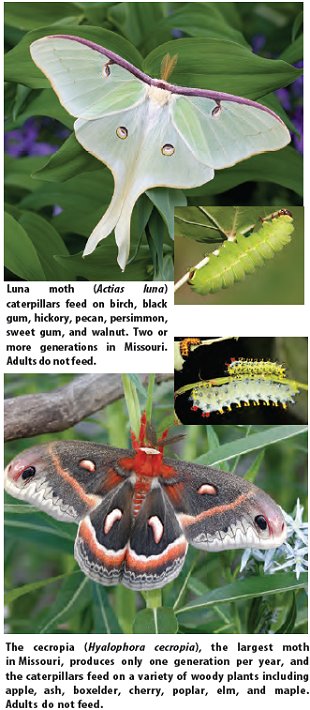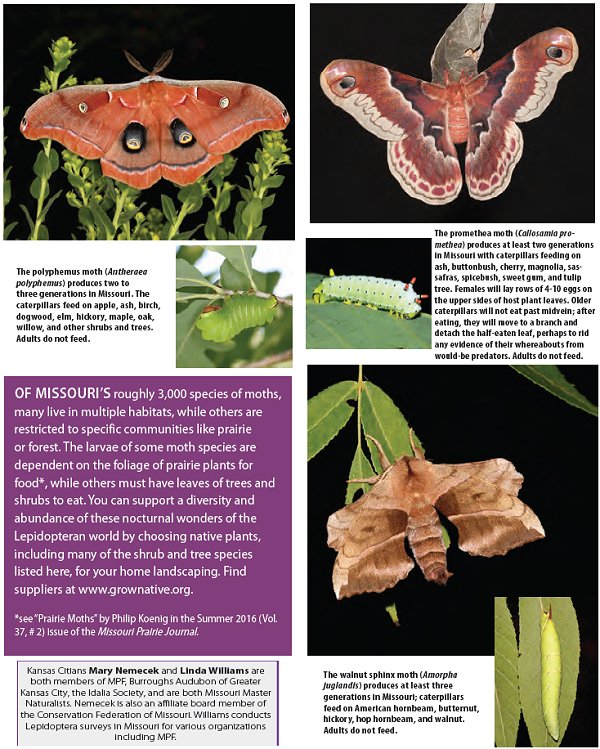AgEBB-MU CAFNR Extension
Green Horizons
Volume 25, Number 2
Spring 2021

Fantastic Moths & Their Woody Host Plants
Text by Mary Nemecek and Linda Williams
Photos by Linda Williams
Most consider butterflies the crown jewels of the Lepidoptera world, but somewhere between where the trees meet the sky and shrubs anchor their roots in the earth live some fantastic moths, which depend on woody plants for most if not all of their lives. They range from large to small and soft to stinging. Some never eat as adults and some feed on flowers during the day, right outside your window.

Giant Silk Moths
Surely the most spectacular of these are the giant silk moths. They have large, brightly colored, velvety wings with pudgy, furry bodies. Adult males can rival any fancy human headwear with their feathery antennae. Their family name comes from their ability to produce silk when they spin their cocoons. Individually, many are named for heroes of ancient mythology. Members of this family include the largest moths in Missouri beginning with cecropia (Hyalophora cecropia), named after the mythical first king of Athens. Not far behind in size and stature is the polyphemus (Antheraea polyphemus), namesake of Homer's one-eyed Cyclops. The adult proudly displays an ornamental "eye" on each hindwing. The title of "most beautiful" may belong to the Luna moth (Actias luna) who, like the others, is active and breeding only after dark, but she alone is named for the goddess of the moon. The polymorphic Io moth (Automeris io) male is fairly plain yellow with brown splotches on the forewing, and the female is a rich mahogany color; the forewings of both hide brightly colored yellow hindwings with red accents and large dark eye markings. The caterpillar can sting. She aptly represents the priestess that Zeus changed into a cow to disguise her beauty. The silk moth family hosts many more species, but closing out those acclaimed in mythology is promethea (Callosamia promethea), a champion of man who stole fire from the gods and gave it to the mortals.
All of the species of the silk moth family feed solely on leaves from woody plants, gorging themselves into large, intriguing caterpillars. Most silk moths are generalists, eating from a variety of plants rather than one species or one family of plants. For example, the cecropia, whose favorite host plants (specific plants on which the caterpillars will feed) include apple, ash, box elder, cherry, lilac, poplar, sassafras, willow, birch, elm, maple, and others. The location of the caterpillars is often revealed by their large frass (fecal pellets) that will dot the leaves and ground beneath them.

As adult moths, they do not feed or drink at all, living only a few days to mate and lay hundreds of eggs. Each female of the species, after emerging from its cocoon, will "call in" potential mates by releasing pheromones at a certain time of night. For instance, the cecropia call right before dawn, and a single female can lure in dozens of males from miles away.
Sphinx Moths
Next in notoriety are the sphinx moths. This is a diverse group with varying habits and traits, 43 species of which are found in Missouri. Some of them will hiss when bothered, such as the caterpillar of the walnut sphinx moth (Amorpha juglandis), while others such as the catalpa sphinx moth (Ceratomia catalpae) caterpillar are gregarious and stay in groups until they reach their third instar (third period of molting)-an eating army that, in years when their populations are booming, can defoliate (yet not kill) trees.
Like the silk moths, the catalpa sphinx moth does not feed as an adult. However, the snowberry clearwing moth (Hemaris diffinis) will consume nectar during the day. Another difference is the snowberry clearwing-often called a hummingbird moth-uses woody vines such as native honeysuckle (Lonicera) as well as buckbrush and woody shrubs as its host plants. Defoliation of trees and other plants by caterpillars occurs in nature and should not cause concern as new foliage will return that season or the following year.
Mind the Spines
While many moth caterpillars look fierce, such as the imperial moth (Eacles imperialis) or the hickory horned devil (Citheronia regalis), it is the fuzzy and spiny ones that should viewed with great caution. The black-waved flannel caterpillar (Megalopyge crispata) looks fuzzy, but those thin hairs hide poison-filled stinging spines that can cause severe reactions. The stinging rose caterpillar (Parasa indetermina) is brightly colored with protruding spines that also deliver a painful sting that many liken to stinging nettle. The slug caterpillars are interesting in that they lay flat, transparent eggs, which allow the development of larva to be observed.
These caterpillars feed on a variety of woody plants such as cherry and oak and can be exciting to find in the field. Look but don't touch-it is best to leave these alone without disturbing them.

Try This at Home
When considering plants for home landscaping to attract wildlife, nectar-producing plants to support butterflies are, of course, a must, but remember to include native trees and shrubs as well. They host many of these incredible moths and their caterpillars, which are not only beautiful, but also play an important role in feeding other species such as nesting birds. If you are looking for plants that host the most diverse numbers of species, start with oaks (Quercus), which host more 500 species of caterpillars, and black cherry (Prunus), willow (Salix) and birch (Betula) trees, which all host more than 400 species of caterpillars. Trees and shrubs can bring amazing Lepidoptera to your yard!
OF MISSOURI'S roughly 3,000 species of moths, many live in multiple habitats, while others are restricted to specific communities like prairie or forest. The larvae of some moth species are dependent on the foliage of prairie plants for food*, while others must have leaves of trees and shrubs to eat. You can support a diversity and abundance of these nocturnal wonders of the Lepidopteran world by choosing native plants, including many of the shrub and tree species listed here, for your home landscaping. Find suppliers at www.grownative.org.
*see "Prairie Moths" by Philip Koenig in the Summer 2016 (Vol. 37, # 2) issue of the Missouri Prairie Journal.
Kansas Citians Mary Nemecek and Linda Williams are both members of MPF, Burroughs Audubon of Greater Kansas City, the Idalia Society, and are both Missouri Master Naturalists. Nemecek is also an affiliate board member of the Conservation Federation of Missouri. Williams conducts Lepidoptera surveys in Missouri for various organizations including MPF.
